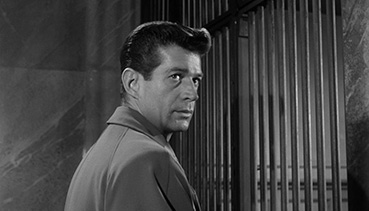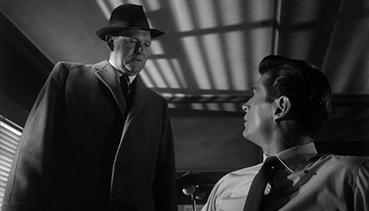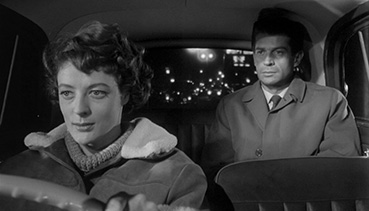|
I always get a small thrill when a film opens in a manner that I've not seen before, particularly when that film is over fifty years old and British. We have, after all, seen our share of crime thrillers that kick off with a bank job or some other nefarious deed, but how many can you recall where the pre-title sequence consists someone breaking into a prison? It's a hell of a hook, all the more so for being staged wordlessly at night, in and out of the shadows thrown by security lighting. Who is this man? What could he be up to? It soon becomes clear when he places a package into a small bag that has been lowered from the window of one of the cells and then nips back over the wall, leaving his rope ladder in place. A short while later the prison staff are alerted by the sound of an explosion, but by the time they reach the cell from which it has emanated, the window is gone and the occupant has fled. The Canadian escapee's name is Paul Gregory, and once installed in the flat that his very English accomplice Victor Sloane has rented as a hideout, he plonks himself in a bath and recalls how he landed in jail in the first place.

It all began with his plan to pull a con on fellow Canadian Harriet P. Jefferson, freshly arrived in London to sell a valuable coin collection bequeathed by her late husband, a scam whose details are smartly devised and best left for the film itself to reveal. The real surprise is that Gregory anticipated his arrest and conviction for the crime and fashioned it into his meticulous plan, reasoning that the five years he will spend in jail would be a small price to pay for the £50,000 haul, which works out at the princely sum of £14,000 a year with time off for good behaviour. Who would begrudge a little jail time for that? The problem is that he gets ten years instead of five, hence his decision to engineer the opening escape. All he has to do now his collect the cash from the safety deposit box in which it was secured (under a false name, of course), then have Sloane procure a fake passport and hop off to Canada. Simple enough, right? Oh, if only.
From this point on were firmly in noir territory, as complications, betrayal and unexpected turns of fate see Gregory's luck go from bad to worse. What sets him aside from any number of his hapless genre compatriots is his level-headed resourcefulness, responding as he does to every misfortune with the same methodical creativity with which he planned the initial con. His actions always have a plausible ring and are often ingenious, but for every smart move he makes, fate is waiting around the corner to trip him up, resulting in a tit-for-tat battle with adversity that rarely allows Gregory time to pause for breath.
Former editor Seth Holt (who co-wrote the script with respected theatre critic Kenneth Tynan from Donald MacKenzie's novel, and who later made his mark with The Nanny and Blood From the Mummy's Tomb for Hammer) directs his first feature with the confidence of a veteran, repeatedly keeping his audience in the dark about Greg's intentions and where the twisting narrative will take him next. His carefully rationed use of Jamaican musician Dizzy Reece's jazz score and his willingness to let tense scenes play out in nail-chewing silence aligns the film more with European noir like Rififi than the genre-defining films from which he clearly draws influence. This is acknowledged in the plot-turning scene in which Sloane reveals his true colours, one whose expressionistically framed camera and Venetian blind shadows briefly transport the film to 40s America (full marks here to cinematographer Paul Beeson, whose other credits include Where No Vultures Fly, Dunkirk and a number of later live-action films for Disney).

Playing it cool throughout as Gregory is Robot Monster's George Nader, who for a good part of the running time has to carry the film without the crutch of dialogue, his good looks, easy smile and pragmatic approach to sometimes self-generated misfortune making him an intriguing and oddly likeable anti-hero. He's backed by a solid supporting cast that's peppered with familiar faces, including Geoffrey Keen as the quietly dogged Inspector Scott, Lionel Jeffries as a pet-shop owner, an almost unrecognisable Harry H. Corbett as underworld kingpin Sullivan, and a young Maggie Smith making her film acting debut as Bridget Howard, the woman who comes looking for the previous occupant of Gregory's flat and who you just know is going to somehow figure later in his adventures. And Bond fans should get a small thrill when Bernard Lee, the man who played M for so many years, reveals the ruthless side of Gregory's long-term accomplice Sloane.
The penultimate production to be released under the Ealing banner, Nowhere to Go was cut by 15 minutes on its original release to squeeze it into a double-bill, but is presented here in its full, uncut 100 minute version. It's one of the studio's darkest films (Seth Holt expressed a determination to make "the least Ealing film ever"), but also one of its most intricately plotted, compellingly handled and criminally unsung non-comedy works.
When you're talking noir you want the blacks to be solid and they're certainly that here, the inky night skies and shadows achieved without punishing the detail in darker areas or burning out the whites. Detail is good for a standard definition picture, the image stable and much of the dust and dirt has been eliminated, though a sprinkling still remains. The contrast range is well balanced throughout. The framing is 1.75:1, a ratio that suggests slight cropping from either 1.85:1 or 1.66:1 to fill the widescreen frame, but the film was shot in Metroscope, which research reveals could be projected at a variety of formats from 1.66:1 to 2.00:1 (a 70mm ratio used on films like Dunkirk), but was most commonly hard matted to 1.75:1, which would make this an exact match.*

The Dolby mono 2.0 soundtrack betrays the film's age a little more readily than the picture, largely through the unsurprisingly narrow tonal range, the sometimes sharp treble bias and an audible background hiss. The dialogue and music are always clear, however, and there are no obvious faults or damage.
Revisiting Nowhere to Go (12:49)
Despite the brief running time, this proves an informative look back at the making of the film and the work of writer-director Seth Holt, co-writer Kenneth Tynan and Dizzy Reece's score. Contributors include writer and film historian Charles Barr, the film's first assistant director Michael Birkett and camera assistant Herbert Smith.
A terrific little British noir thriller from 1958, plucked from obscurity and restored to its original length by Studiocanal (who are about to hand over their long-standing project to release little seen British films from years past to Network). Not much in the way of extra features, but for the film itself this still comes enthusiastically recommended.
* http://www.reelclassics.com/Techtalk/aspectratio-article.htm
|